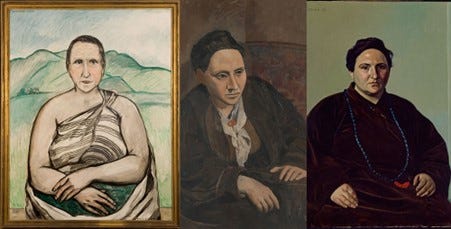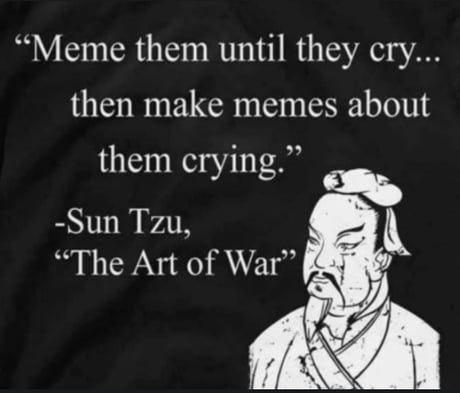What do writers and King Ghidorah, the arch-enemy of Godzilla, have in common? They are both made into memes. As can be seen, the meme consists of labeling the first two heads with objects of superior quality, while the goofier head is attached to objects that are less so.

The Three-Headed Dragon meme, when it comes to the literary world, would probably have an author’s public persona as the googly-eyed, silly Ghidorah, who acts without inhibition, is completely out of control, and is constantly sneered at by the author’s work and self. Writers confronted their world as a three-headed beast, one entity with a single name and three discrete parts: one’s work, one’s public persona, and one’s private self. Gertrude Stein immediately comes to mind.
The author, as for her contemporaries before World War II, was keenly aware that her literary reputation and public personae are intrinsically linked. As Ann Douglas summarizes, “The dangerous business of attention management and exploitation fascinated all the writers of [this] generation, whether as subject matter or lifestyle or both.” The likes of F. Scott Fitzgerald, Mark Twain, Ernest Hemingway, and Stein herself struggled with the infrastructure of new media and newly developed means of promotion. Before she was ever successful, the author hired a newspaper clippings agency to keep track of whenever she or her work appeared in the popular press. Yet, she initially refused to play “the game,” one in which authors embrace the nuances of self-promotion – of which Normal Mailer’s engagement with mass media is exemplary – and stuck to her trademark prose, until The Autobiography of Alice B. Toklas (TAAT) in 1933. Stein would later go back to her original style, but TAAT marked a breaking point of her career: a breakthrough of global proportion, yes, but also a moment of compromise, of creative insecurity, and of identity crisis that would persist in her writings years after. Her success with TAAT was the result of “meme-ing” herself, dropping her label as “the genius writer whose writings are extremely difficult to understand” into a sort of parody of herself, offering easier-to-grasp writing and gossip to finally step foot into fame.
After TAAT, Stein dropped into a state of constant “confusion,” in which she mistakes her public persona for her own. In Everybody’s Autobiography, her second memoir, Stein claims that the fame she attracts from TAAT distracts her from her literary essence. While this declaration of artistic intent marks Stein's effort to establish the sincerity of her work, it also suggests what the public wants from her: the obscurity of her writings. Although she was famous, Stein also understood the obligation of that fame, and her return to form after TAAT was the author’s attempt to prove herself as a talented writer, not just a crafted phenomenon who succumbed to demands.
Thus, Stein’s subsequent failure marks what the author had feared: her fame was meditated by the public, or at least how the public sees her. One of the natural causes of dead of memes: as soon as the celebrities depicted in memes are aware of them, and use them, the meme immediately loses its charm.

It is not such a peculiar phenomenon for celebrities to hop on social media trends, but most of them would lead to either more memes or a concurrent face-palm so strong from the population that it registered on the Richter scale. Hillary Clinton’s famous “Pokemon GO to the Polls” is one such example.
The best memes about celebrities are ones they had no idea about. Stein was stuck in limbo, as her admittance of writer’s block shows, how to maintain the public’s gaze while still keeping her artistic integrity. On one hand, if she was to continue writing more readable pieces like TAAT, she would lose her #geniuswriter and the mystique she has built around that title. On the other hand, and as a matter of fact, if she did what she did, no one would buy her book. She was stuck between a rock and a hard place, surrounded on all sides by the faceless media that wanted to shape her like babies and clay.
And this sculpting of celebrities is even more relevant now in the age of the Internet. Like Michelangelo and David, Memes are a gateway through which fans develop a relationship with those they only see on TV. Rather than passively reading gossip, we are reacting to news with comments, and hashtags, with memes and outrage. Because memes are user-generated, and easily made by anyone with a smartphone, tablet, or laptop, the ball is now completely in the public’s hand. Instead of simply consuming media, we now both produce and consume media.

Imagine the portraits of Gertrude Stein (Figure 3), but instead of famous artists, anyone with a smartphone can produce one. The aforementioned consumption, or the fear of it, was perhaps most apparent to Stein during her American tour. The more she devotes to the personality she has crafted in TAAT, the one the public looks for, the more her writings fade into the background. At the time, Stein was read about more than read.
Yet, Stein’s effort was not for nothing. In her courageous insistence on authenticity, a style uniquely true to herself, Stein has managed to post-mortemly evade the post-authentic world created by the unholy matrimony of mass media and technology.
A browse through Facebook and one is bound to come across memes like Figure 4, but not in this exaggerated form. The poster often guised these quotes, attributing a famous person’s saying to another’s, or misquoting them completely in order to fish for “likes” or “upvotes.” And since memes spread like wildfire, it is not far-fetched that the problem of authenticity becomes muddled. The worst comes in the second half of the year 2022. A debate surrounding the authenticity of art sparks worldwide attention: an Artificial Intelligence called Midjourney won the Colorado State Fair’s annual art competition.

Although these technologies have been around for years, Midjourney’s victory has understandably troubled many an artists for their own future. If art can be generated by random prompts (how Midjourney and many A.I. programs initialize drawings), what then is the point? Fortunately, A.I. writings have not reached that far, but supposedly they will, then would writers be out of work? Not for Gertrude Stein, and certainly not for those artists who crave for their authentic voice to be heard. An A.I. might one day write something “Gertrudestein-esque,” but never can it be Gertrude Stein. Perhaps we have been far too eager to judge her tour of America. At the onset of Everybody's Autobiography, the author says "Jo Davidson always said one should sell one's personality and I always said only insofar as that personality expressed itself in work." Here, Stein feels finally at peace with her public image, finally caught up with “the game:” It is okay to sell yourself, she seemingly suggests, as long as that “self” contains and highlights the essence of her writing. This “essence,” she explains to the horde of people that comes to her lectures, some of them presumably writers themselves: “If you write the way it has already been written ... then you are serving mammon because you are living by something someone has already been earning or has earned. If you write as you are to be writing then you are serving as a writer god because you are not earning anything.”
On the journey of becoming a writer, none can escape the lustful hands of mass media or the threat of being eventually replaced by a software. The three-headed beast will fight among themselves but heed Stein’s advice, she lived it: authentic self-expression can and will be your saviour.




